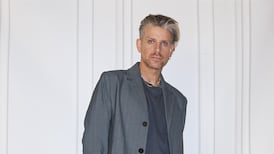Drive a 4x4? Think you're a dab hand with a map and compass, even in the dark? Marc Bezier watches the teams in an 800km charity challenge find their way up a mountain in the dead of night
It's late at night on a damp Saturday in early October. My toes are cold, my feet are soaked and it's so dark I can't see the end of my nose. I can hear talking and crackles of distortion from CB radios, and I know I'm close to water, as I can hear it rushing by.
There's an air of anticipation, like the moment you feel the air warm before a thunderstorm. A man with a torch and a fluorescent jacket has just walked over and handed me a mug of coffee. "They'll be here in a minute," he says and walks away. He said that more than an hour ago, too. I'm just finishing the coffee when I'm sure I can hear engines. I peer into the blackness. Far away I can see lights twisting, sometimes disappearing, but the noise never does: it gets louder and closer.
Suddenly, a vehicle approaches the water opposite me. It crunches to a halt on the gravel track, its headlights shining over the river, then leaps forward, creating a dazzling fountain of spray that reaches up and out into the night. The headlights of vehicles behind catch the spray, too, and the water shines. The din of engines echoes through the valley as a stream of four-wheel drives snakes down the mountain track and plunges across the narrow ford. I turn and watch the tail lights bounce as they fade into the night, and shortly after all is still again.
This spectacle can only be the first Irish 4x4 Challenge 4 Charity, in which teams of two - driver and navigator - travel some 800 kilometres (500 miles) through seven counties. I've just watched the night stage that brings the first day of the two-day event to a close. The teams set out from Limerick this morning on a journey that has seen them drive on- and off-road through Co Clare and Co Galway, to finish high up here in the mountains of Co Mayo.
The event is modelled on the Macmillan 4x4 UK Challenge, which last year raised more than €75,000 for cancer care. The money it raises will help redevelop the intensive-care unit at Temple Street Children's University Hospital, in Dublin. The challenge is open to all, even complete novices, and its organisers are keen to point out that the event is not a race and that the rules of the road must be obeyed - it could best be described as four-wheel driving meets orienteering. "We are not out here to chew up the countryside," says Robert Archibald, who has helped to plot the route. "This is a navigation exercise, a test of skill, and we work from a tread-lightly policy. Eighty per cent of the route is on Tarmac road, and the whole route should be driveable on normal road tyres." The entrants, armed with a clutch of maps, are given day books that offer a mix of instructions, including six-figure grid references that, if interpreted correctly, will see them to the end. Along the way, marshals operate control points. The entrants notch up a score by answering questions on local knowledge from their day books and noting down lettered marker boards along the way.
I catch up with the teams early the next morning, at a campsite. The 8am briefing has just finished, and, still weary from day one, the contestants wander back to their vehicles to study the day books. Highlighter pens are out as they start to digest the information and plot their courses. Teams are not allowed to use any form of electronic positioning equipment, although a compass and magnifying glass, to enlarge the cartography, are allowed. A few people are packing away tents, but most have slept in their vehicles. Some are busy frying breakfast on small gas burners and slugging down cups of tea. Gerry Brennan, one of the drivers, says he lives only 30km (20 miles) from the campsite. He started to prepare his vehicle last Thursday - changing a broken clutch fork into the small hours of Friday morning - then crossed the western seaboard all day. Last night he was so shattered that, although he would have loved to have seen a hot meal, a bath and his own bed, the thought of driving for a minute longer saw him bed down in the back of his vehicle at the campsite.
Two men in a vintage Land Rover have the toolbox out and are busy under the bonnet. The driver, Vincent Knight, who also owns the vehicle, says they spent the night in a nearby B&B. "The vehicle isn't long enough in the back to sleep in. Also, I had the seats changed, as the old ones were worn out. I got hold of a set from a Ford Fiesta in my local breaker's yard. I sat in them and they were comfy, so I had them fitted. The thing is, they are too high to see clearly out of the windscreen. You have to strain your back, bending forwards as you drive to see out properly. I don't have power steering, and only basic leaf-spring suspension, so our backs are crippled. We had to get a proper bed last night, so we missed the night-navigation section." Apart from the stooped backs, they are finding it a fun event with a great atmosphere. "Everybody goes wrong along the way, and at one point we didn't even know what county we were in. Driving the coast road in Co Clare earlier in the day, I asked my navigator a question from Zen and the Art of Motorcycle Maintenance: 'At what point does the man become the machine?' He drily replied 'Fanore' as we drove through it."
The teams leave the campsite at three-minute intervals, to head east to Co Roscommon. Along the way they must be on their guard to answer questions on tidy towns, the width of bridges, the names of rivers and the heights of mountains, to name but a few. At the village of Arigna, the teams head north along the western edge of Lough Allen and up Corrie Mountain. Once mined for its coal, it is a labyrinth of dirt tracks. As we drive up the steep mountainside, Jonathan Crozier, one of the organisers, says: "They'll have to be careful and clever up here, as the area was last mapped by Ordnance Survey in the 1990s, and whilst the maps are highly accurate, the map datum can be up to 10 years old. They can't rely on mapped tracks left from the mining, as the last mine closed in 1990. New tracks have been put in all over the area, to facilitate forestry and wind farms. They'll have to calculate the distance travelled as well as studying the topography. Observing the contour of the land can aid you immensely in pinpointing your location."
We watch as a slow procession of four-wheel drives crests the incline. Sure enough, most start heading along different tracks. Some stop and look over at fellow competitors, wondering if they are on the right route; others drive past and try to read the marshals' expressions for any hint of a clue. "We might not always be parked up along the right route, so if you spot a marshal's vehicle you shouldn't necessarily make for it," says Crozier. A tyre bursts on the photographer's vehicle, and a couple of competitors stop to volunteer a helping hand. "That's the unique spirit of this event; it's not a race," he says. The winner is the team that answered the most questions correctly and noted the most marker boards. "You can stop for a tea break if you wish. It'll make no difference to your ranking as long as you complete the route."
For the final and highest stage, the teams head up a road onto Bencroy Mountain, in Co Leitrim. From here they drop into Co Cavan to the finish, at the Slieve Russell Hotel. Gerry Brennan and his navigator, Ciarán Murray, who are from Curry, in Co Sligo, take first prize. "I have never done anything like this before," says Murray. "I did think back to my school geography days, but I'm completely new to all of this." I ask Brennan for their secret formula. "There is none. I said to Ciarán at the beginning: 'I'll drive and you read the map. I will trust you, and if we go wrong I will not fault you. We will make mistakes, but we will be a team.' "
Each pair paid an entry fee of €150, to cover administration, the campsite, the awards dinner and a nightat the hotel. All teams receive a piece of engraved crystal, and in addition to the winners' prize there are other awards, including for the most sponsorship, which this year goes to Peter Wallace and John Haines, who have raised more than €1,200 for Temple Street.The Spirit of the Event award goes to Kevin and Margaret Stone, from Co Westmeath, who were first on the scene to help the stricken photographer. The husband and wife were so shattered that they went off to bed as soon as they finished, sleeping through the awards dinner.
After the dinner, competitors recall tales of temporary insanity and friendly sabotage. One sneaky joker, early on the second day, cable-tied the prop shafts of some of the vehicles. Another team, unsure of their location and required to answer a question with a photograph of particular ruined stone cottage, ended up photographing no fewer than 26 ruined cottages along the stage. "The night navigation was really hard," adds one navigator. "You'd look out the side window for a landmark as a reference point, and all you'd see was the black of the night. If you lost concentration for a second, you were soon scuppered." "The marshals really loved winding us up," says another. "At one control point we drove through the marshals were singing Talking Heads' Road to Nowhere."
You can register for next year's event by visiting www.4x4challenge.org or by calling Jonathan Crozier on 087-6342434










